What Does Pesto Taste Like?
When you buy through our links, The Breslin may earn an affiliate commission. Learn more
Are you wondering “what does pesto taste like?” I bet that you are because you’ve reached this post! Your curiosity will be taken care of by this article. So keep reading to get more interesting information about this question!
Pesto is such a common sauce to use in Italian dishes that you might happen to taste it before but you did not notice how it tastes. Therefore, I will specifically describe the flavor of pesto for you to imagine. Before we start, there’s something you should know about pesto!
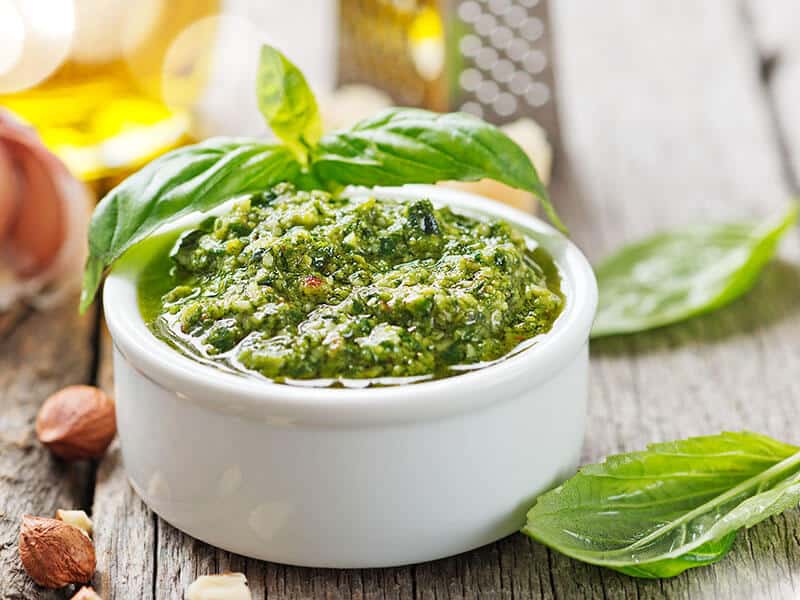
What You Should Probably Know About Pesto
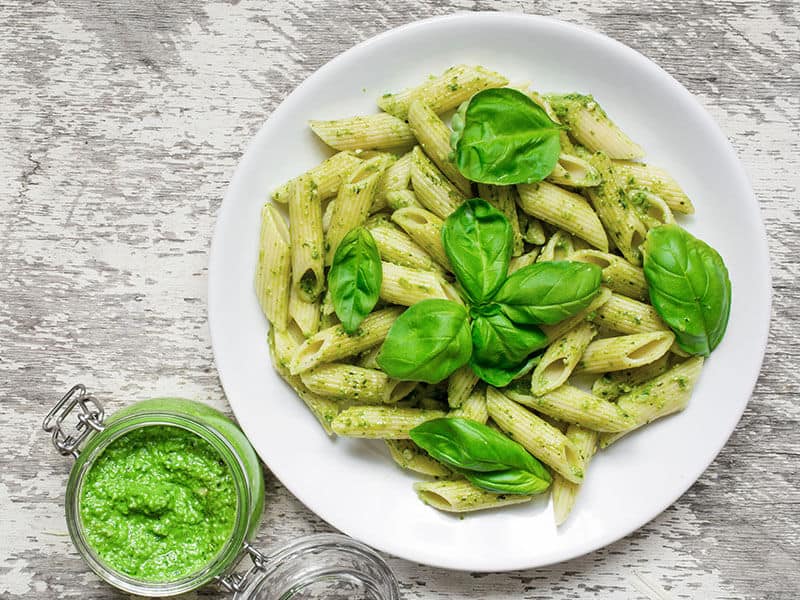
Pesto is a sauce from Genoa, Italy that is made of many ingredients, mainly herbs. Traditional pesto has a very signature and beautiful bright green color.
In Italian, “pesto” is the past form of the verb “pestare,” which literally means “to crush” or “to pound.” This clearly indicates the way how pesto is made – it is made by crushing all the ingredients together to create a solid texture for the sauce.
There are a lot of pesto variations with different colors, components, and recipes. But the simplest type of pesto may include basil, garlic, olive oil, chese, pine nuts, and spices such as salt and pepper. Parmesan cheese is commonly used to make classic pesto.(1)
The most typical dishes using pesto as the main sauce are pastas and chicken sandwiches. Pesto is a versatile sauce that can be applied to many recipes and help boost the dish’s overall taste. You can also mix it in a dipping sauce or a dressing for your salad!
Pesto is widely sold in stores or supermarkets so you can easily purchase it any time. But nothing can beat the homemade pesto sauce! If you have time, making pesto at home is not a bad idea! This post is gonna provide you with some easy-to-make pesto recipes!
To Briefly Describe The Taste Of Pesto
The taste of pesto actually varies based on the ingredients in each type. There is no exact and fixed taste for pesto. However, the traditional pesto with the most basic components can be described as earthy, garlicky, rich, creamy, and a little bit salty.
As you can see, the pesto’s flavors depend a lot on its ingredients. A well-made pesto can make you feel the taste of every single food element inside! The earthiness is from basil, the garlicky flavor is from garlic, the saltiness may be from cheese and salt, etc.
Sometimes, your pesto may taste like grass and nuts from the number of herbs and pine nuts they are added to. If there are too many herbs and leaves, such as basil, the taste will be intense with earthiness and herbiness.
Since the sauce is made by crushing everything together, the amount of each ingredient should be added equally, so that none of them tastes over- or underpowering in the sauce. Let’s find out what’s in pesto that can directly affect the taste of this green sauce!
What’s Inside The Traditional Pesto?
There are tons of classic pesto recipes in the world that call for a lot of ingredients. But I will show you some basic components of traditional pesto and how their tastes impact the sauce!
1. Basil
Basil is one of the essential elements of pesto to create the signature green color and the earthy taste. Its leaves are usually used in pesto, which gives the sauce a refreshing, peppery and a little sweet taste.
The flavor of basil usually stands between savory and sweet, with the undertones of anise and mint, besides the peppery notes. It also adds a sweet hint to the dish.
Some pesto recipes substitute basil with parsley, kale, cilantro, sage, arugula, tarragon, or mint. These herbs can be great replacements but they won’t guarantee the unique taste of pesto.
2. Garlic
Garlic is the runner-up of “the most important ingredients in pesto” contest! Without garlic, pesto isn’t called pesto anymore. The garlicky flavor builds up the one-of-the-kind taste of pesto! Therefore, you should not discard garlic from the recipe by any chance.
People usually describe the garlic’s taste as spicy, but it actually adds heat to the meal and is “spicy” in its own way. Garlic is also somehow earthy and hard to tell. What an iconic flavor!
However, there should not be too much garlic in the recipe, since it has a strong odor that can easily dominate the flavors of other ingredients.
3. Cheese
Parmesan cheese is a famous cheese to use in pesto. It can also be replaced by Parmigiano Reggiano, Asiago, Pecorino Romano, Grana Padano, Pecorino Sardo, and many more types of cheese.
If you like to add your favorite cheese, it’s okay. Any cheese will do, but it should ripen and be a little bit salty. It should also be hard and dry because the cheese is usually grated in a pesto recipe. Italian cheeses are preferred.
In pesto, grated cheese brings a salty, cheesy, buttery, and creamy taste to the sauce. Pesto becomes richer when having cheeses join in!
4. Olive Oil
Olive oil also plays a vital role in the classic pesto. If the oil is of premium quality, it will enhance the sauce’s natural grass-like and herby taste.
Store-bought pesto often replaces olive oil with other oils to lower the production price, so you may not get any exceptional taste from olive oil in canned pesto.
5. Spice
Salt is a common spice to boost the pesto’s flavor. However, be aware that the saltiness from cheese can be enough for the sauce, so try not to add too much salt. Just a pinch is okay, or you can adjust the amount to your likings.
Red or black pepper is sometimes added if the consumer likes to have a hot and spicy sauce. Crush or puree the pepper before getting it into the sauce.
6. Nuts (Optional)
Adding nuts is not a bad idea if you like to have a crunchy texture in your pesto! Many species of nuts can be used in pesto, such as pine nuts, cashew nuts, almonds, and walnuts.
Nuts provide a nutty, fatty, and rich taste to the pesto. It also makes the green sauce’s texture thicker and more solid.
The classic pesto can’t be easier to make with these available ingredients in your pantry!
Can you imagine how the pesto tastes now? If you’re still a bit confused, let me take you to the next section, which will fully describe the flavors of some specific types of pesto to you!
Red Pesto Vs. Green Pesto – Two Scrumptious Twin Sauces
The pesto has two distinct types of appearance: one is green, and the other is red – two opposite shades. The colors come from the main ingredients of pesto. The green one is already known to come from basil leaves, how about the red one? Try to guess it!
The Basic Green Pesto
The signature color of pesto is green, and there are a lot of varieties for green pesto in the world! The traditional ingredients and tastes of green pesto have been revealed in the previous section, so I won’t talk more about them here.
Let’s jump to some famous variations of green pesto and see what their characteristics and flavors are!
1. Classic Basil Pesto (Pesto Alla Genovese)
This is the traditional green pesto that I’ve always mentioned. It is made of the most basic ingredients and is the one to be used in most restaurants for dishes including pesto.
The earthy basil leaves, the aromatic garlic, the creamy and a bit salty cheese, and the crunchy nuts all create the best green pesto you could ever imagine!
2. Citrus Pesto (Pesto Agli Agrumi)
Pesto agli Agrumi is also called citrus pesto since it includes orange or lemon juice in the recipe. This pesto’s components are just like those in pesto alla Genovese, except for the nuts. This recipe calls for almonds instead of pine nuts.
With the pleasant sourness of citrus fruits, pesto agli Agrumi tastes bright and refreshing. It can pair really well with seafood pasta.
3. Garlic Scape Pesto
Garlic scape pesto is a mild pesto recipe for those who are not used to the intense taste of the traditional green sauce. It is made of garlic scapes, which are the stalks growing from the bulb of a garlic plant. The scape has a light taste of garlic.
This green pesto is perfect to serve with bread, egg pasta, roasted vegetables, etc. If you don’t have garlic scape on hand, garlic and chives might be great alternatives.
Learn how to make perfect garlic scape pesto from an expert!
4. Pepita And Cilantro Pesto
This sauce is inspired by Mexican cuisine, thanks to cilantro as the main ingredient. It includes toasted pumpkin seeds (pepitas) that bring the toasty flavor to the sauce. The cilantro may taste unpleasant to some people, but it provides a herby taste for this pesto.
Mix this pesto version with some pasta and toast, you may fall in love with it right away!
5. Parsley Pesto With Anchovies (Pesto di Prezzemolo)
As in the name, parsley and anchovies are the two key elements of pesto di Prezzemolo. It has the intense and salty taste from anchovies, together with aromatic parsley sauce.
Pesto di Prezzemolo gets along well with boiled or grilled veggies. Its flavorful taste blends with the mild and natural sweet veggies to create an exploding combination!
Your homemade green pesto turns brown after a few days? Here are some useful tips!
The Unique Red Pesto
Guess what builds up the red color of pesto! It’s the tomatoes, and sometimes the red pepper! Red pesto also includes basic ingredients like garlic and cheese, but the main component is what makes up the taste of red pesto.
Red pesto in general has a natural sour and umami taste. It is not as common as the green one because the tomato sauce can stand in for it in most cases.
1. Sicilian Pesto (Pesto alla Trapanese)
Pesto alla Trapanese is a famous tomato pesto sauce from Sicilia. It uses almonds and Pachino tomatoes in the recipe, which creates a special taste. It has a delightful, bright flavor to tell.
Pesto alla Trapanese will be a great summer sauce for you to have in the kitchen. It’s best when combined with pasta, crostini, or roasted veggies.
2. Sun-Dried Tomato Pesto (Pesto Rosso)
Pesto Rosso is famous for the beautiful red color from sun-dried tomatoes. However, other ingredients of this red pesto vary in different versions. So this pesto doesn’t have a fixed recipe to use.
Sometimes, there are rosemary, olives, almonds, or even red peppers in pesto Rosso. But this red sauce tastes spicy and intense in every way.
3. Roasted Red Pepper Pesto (Pesto alla Calabrese)
This Italian-inspired pesto sauce is extremely hot and spicy with red bell peppers. Plum tomatoes and eggplants are also used in this recipe, creating a unique flavor for the sauce.
Try pesto alla Calabrese if you like to eat spicy foods and you’ll love it! Include it in your favorite pasta, sandwiches, or even pizza!
Make roasted red pepper pesto from the easiest ingredients available in your kitchen!
Why Does My Pesto Taste Unusual?
Sometimes, your homemade or store-bought pesto will not taste like you thought it should be. It may consist of a strange and intense odor or flavor that makes you wonder whether it is still safe to eat or not. Read on to find out about some common cases!
My Pesto Includes Weird Sourness
This usually happens with store-bought pesto or pesto that has been left too long in the fridge. Keep on reading to figure out if this is an indication of spoiled pesto or something else entirely!
It Includes Acidic Elements
There are some pesto brands that add citric acid or lemon juice to their product for preservation reasons. Therefore, if you happen to buy pesto from those brands, you may detect some sour taste in the sauce.
You should carefully check the label printed on the pesto jar. If it does have some additives that contain acidic elements, then it may be fine to consume. Don’t worry too much about that!
It Has Probably Turned Awful
If you take your pesto out of the fridge for your sandwiches, but you suddenly notice the sour smell from the pesto, then it’s probably getting rotten. Both store-bought or homemade pesto has a shelf life and can be bad after a while.
I will talk more about pesto expiration dates as well as how to store pesto properly in the next sections. But once your pesto doesn’t taste as it used to at the beginning with a rancid smell, you should discard it as soon as possible because it may have fermented.
My Pesto Is So Bitter Like Grass
The grassiness and bitter aftertaste may be the signature flavors of pesto, but when these tastes are overwhelming in this green sauce, it may be an unusual sign telling that there’s a problem with your pesto! This sign usually appears in homemade pesto.
It May Contain Too Much Olive Oil
If you made yourself a jar of pesto at home, try to adjust the number of ingredients you put in the sauce. Because if you add too much olive oil or virgin olive oil, your pesto will become very bitter since the oil includes polyphenols – molecules that create a bitter flavor.
The polyphenols covered with fatty acids will be released while you blend them with other ingredients in a blender. Therefore, your final pesto may taste really bitter and hard to eat.
It Has Too Many Herbs And Leaves
Another important component that should be modified carefully while making pesto is herbs and leaves. If you put too many of them in, the stems on – for example – the basil leaves may cause the natural bitterness that makes your pesto taste intensively like grass!
Easy Ways To Save Your Bitter Pesto
Don’t worry! You can save your bitter outcome by adding more ingredients with strong flavors like garlic, cheese, or nuts. This can decrease the bitterness of the overwhelming olive oil, herbs, and leaves. Moreover, you can add some non-bitter leaves like spinach.
Besides, adding more salt is also a great choice. The saltiness can somehow fade away the bitterness. Remember to taste your pesto again and again while adding salt, since it might get over-salty. Another tip is to serve your pesto along with some salty main dish.
Learn How To Store Pesto Effectively
Storing pesto is really easy if you know how to do it right. But you won’t need many tools for this. It’s a simple but also important step to do after you purchase it at the supermarket or make it by yourself at home. Read some of my tips for storing pesto!
Store-Bought Pesto
You should choose the best jar of pesto right at the beginning. When you’re at the supermarket, hit the unrefrigerated section of sauces. Why? Because the sauce jars in this section can mostly last longer than those in the refrigerated one.
When you get the pesto jar home, you can both store it in the dry kitchen cupboard or in the fridge, with the sealed condition. If you store it at room temperature, make sure that it stays away from the sunlight and moisture.
Once the pesto jar is opened and used, always put on a lid and store the left sauce in the refrigerator. Remember to seal it tightly with any air getting in! If the container is broken or the lid can’t be securely closed, you should move the sauce to a new sealed container.
Homemade Pesto
You should always begin to make the pesto sauce with fresh ingredients! Fresh basil leaves, fresh garlic, fresh cheeses, etc. If you can guarantee the freshness of every single element in the sauce, it will last longer than you thought it should be!
After successfully making the sauce, move all of it to a moderate container with a tightly sealed lid. This is a very important thing when storing this green sauce.
Because the homemade pesto is already considered as the opened sauce, it lasts shorter than store-bought one. It should always be kept in the fridge for the best quality. Only take out enough pesto to use with a clean spoon, and close the lid tightly after use.
How To Tell If My Pesto Turns Bad?
Pesto sauce, whether homemade or purchased in a jar from the store, will inevitably go bad. It is mainly because of the fresh basil, nuts, and vegetable oil, which easily get rotten and rancid after a few days.
Below are some signs telling that your pesto may be bad and need to get rid of right away:
- Appearance: The visual element can never lie! If your fresh, beautiful bright green pesto turns to a dark brown and dry mixture, it’s probably gone bad! But it isn’t enough to conclude that it’s bad, you should continue to check for other signs, too.
- Smell: Do a sniff test to see whether your pesto still smells normal or not. If it has a strange, sour, rancid odor, it is an apparent sign showing that the pesto has been rotten!
- Taste: If your pesto doesn’t taste as good as it used to with some awkward flavors, such as too sour or bitter, it can be a huge alarm to tell you that the pesto can’t be used anymore and you should toss it away.
How Long Does Pesto Last?
Like many other sauces, pesto has its own shelf life. It depends mostly on the storing condition and whether the store-bought pesto jar is opened or not. Homemade pesto is considered an “opened” pesto. Here’s a simple chart for you to figure it out!
With the store-bought pesto, you should notice the expiration day printed on its label. If it is kept sealed until the best by, it can last for a few weeks more. Once you open the jar, it can only last for no longer than 2 weeks.
With the homemade pesto made of completely natural components, you should use it within one week! Avoid leaving it at room temperature because it will go bad sooner. Always use fresh ingredients that you just bought from the store or supermarket.
This shelf life is correct only when you store your pesto properly. And it should always be stored in the refrigerator for the best quality!
Some Incredible Health Benefits Of Pesto
Pesto is a natural sauce that consists of many healthy ingredients like herbs and nuts that can positively impact your body. Here are some outstanding health advantages of pesto:
- Reduce bad cholesterol in your blood: The veggie oil in pesto includes unsaturated fats that can help decrease the harmful cholesterol levels in the body.
- Provide protein and calcium for your bones: Protein from plant-based ingredients in pesto can benefit your bones and muscles.
- Provide vitamin C for your immune system: Pesto consists of many vitamin C, which can help fulfill the daily intake and assist the immune functions. (2)
Some Simple But Delectable Ideas To Deal With Pesto
This green (or red) Italian sauce can be used in numerous ways. The most typical dish to go with pesto is pasta. You can find pesto in many types of pasta, and also sandwiches. But pesto can do more than that! Here are some simple but brilliant ideas for using your pesto!
- Replace your pizza sauce with pesto. It will be an interesting condiment for your pizza!
- Mix pesto with some cream cheese and use it as a dipping sauce for roasted meat, such as beef steak, pork, chicken, etc.
- Make a delicious breakfast with pesto by scrambling some eggs and veggies then pour the pesto onto them.
- Cook vegetable galette with your pesto. It will be a hearty main course!
- Spread pesto on bread and bake it in the oven.
- Mix pesto with mashed potatoes and bake or roast all of them together to create a perfect potato-based dish!
- Make pesto popcorn with a special sauce of butter, oil, salt, pepper, and some grated Parmesan cheese to get an amazing popcorn for movie nights.
And there’s a lot more! Try to think outside of the box and make use of your pesto in the fridge before it gets rotten!
FAQs
Here comes the Questions and Answers section! You may have a lot of things to ask on this topic, so I will provide you with some frequently asked questions and quick answers so that you can get some more interesting information about pesto!
Are You Ready To Taste Some Pesto Now?
Of all the information about pesto’s taste above, which one impresses you the most? Does all of that satisfy your curiosity? I hope that this article inspires you to taste some pesto if you haven’t experienced eating it!
And if you find my post helpful, don’t hesitate to hit the like and share button! Having some more questions for me? Leave some comments below! I will answer all of them if they’re something that I know about! Thank you so much for reaching this line!
References
- En.wikipedia.org.. Pesto – Wikipedia.
- LIVESTRONG.COM.. Is Pesto Sauce Healthy? | Livestrong.com.

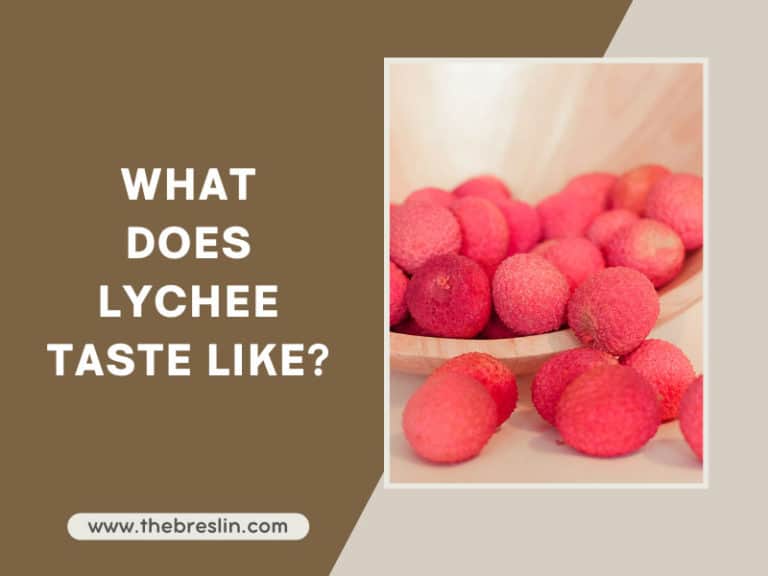

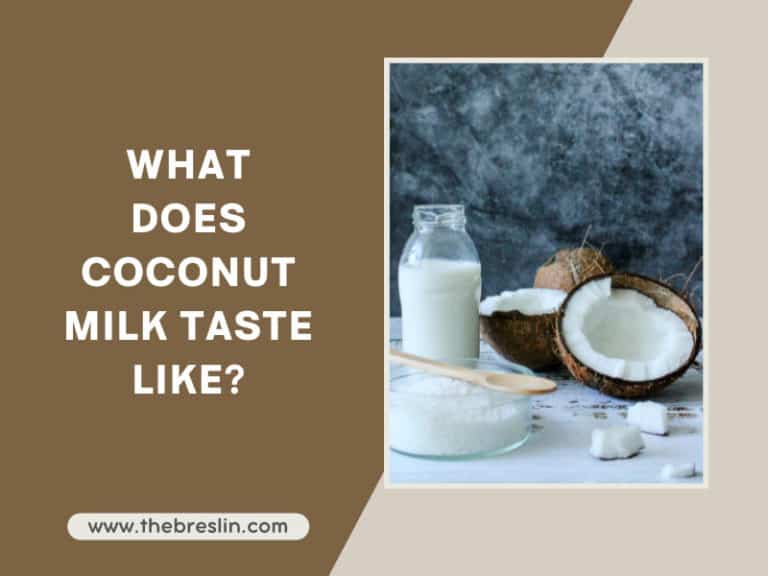
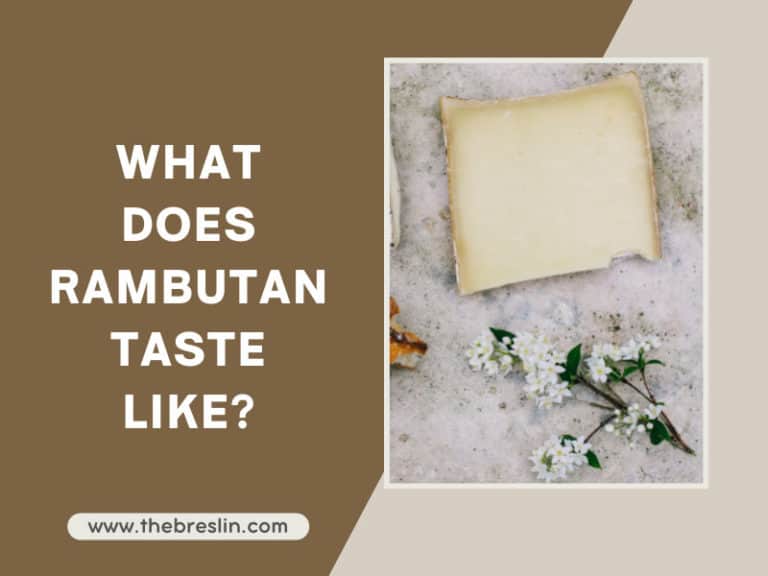
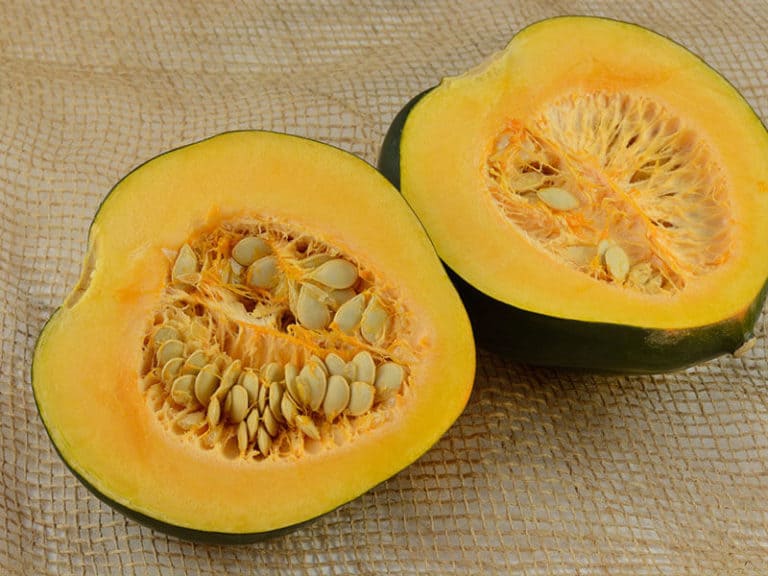

Amanda Collins
Founder and Senior Culinary Editor
Expertise
Culinary Arts and Management, Food Journalism and Critique, Recipe Development and Testing, Global Culinary Traditions, Sustainable Food Practices
Education
Institute of Culinary Education (ICE), New York, NY
Program: Diploma in Culinary Arts
Focus: Intensive hands-on training in culinary techniques, recipe development, and kitchen management, preparing students for professional roles in the culinary industry.
Monroe College, New Rochelle, NY
Program: Associate in Applied Science in Culinary Arts
Focus: Practical culinary skills, including cooking techniques, menu planning, and kitchen operations, with an emphasis on hands-on experience and industry standards.
Amanda Collins is a seasoned chef and food editor with a deep love for global flavors. Trained at the Institute of Culinary Education and Monroe College, and with over 15 years in the culinary field, Amanda has refined her skills in kitchens worldwide. Her background in food studies gives her a unique ability to share both recipes and the cultural stories that shape them.
As senior culinary editor at thebreslin.com, Amanda’s work brings authentic dishes to life, inviting readers to explore new flavors and techniques from around the globe. Her approachable style makes it easy for anyone to bring a bit of the world’s cuisine into their kitchen.